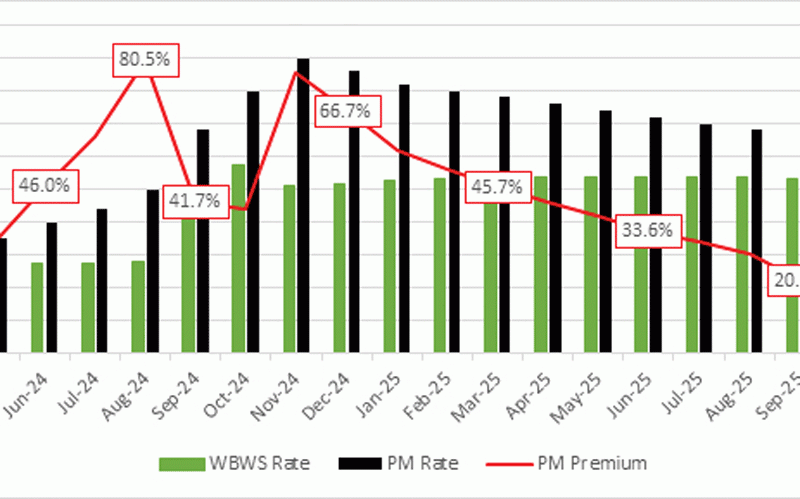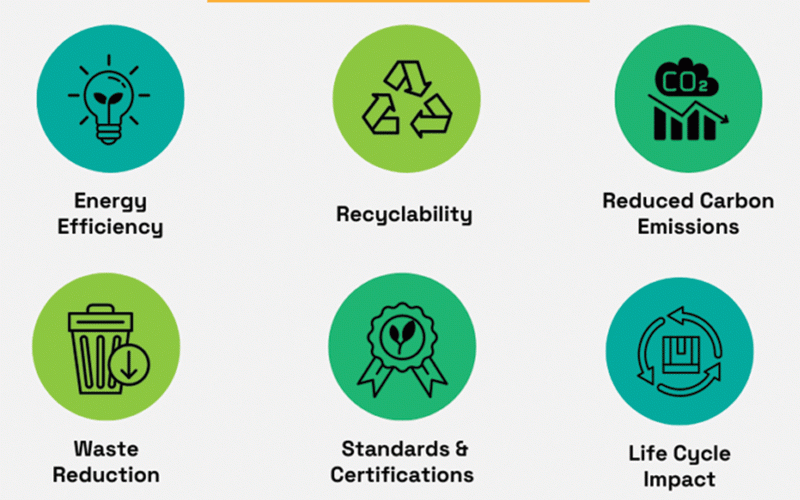
ZIMBABWE’S macro-economic landscape has been characterised by volatility, marked by unpredictable exchange rates and soaring inflation.
This persistent instability has pushed authorities to take decisive action by replacing the Zimbabwe dollar (ZWL) with the reserve-backed Zimbabwe Gold (ZiG) in April 2024 — a bold step towards economic stability.
While early days have seen some challenges for the ZiG, recent data show promising signs of stabilisation, with the average parallel market premium and price inflation trending downward. This emerging relative stability is a crucial development for Zimbabwe’s economy. Therefore, this column analyses key macroeconomic developments in the third quarter of 2025 (3Q25), providing essential insights into the country’s economic condition.
It also includes informed outlook projections, including potential risks that could affect both businesses and households.
Exchange rate
In September 2025, the ZiG appreciated by 0,4 percentage points against the United States dollar on the willing-buyer willing-seller (WBWS) interbank market, closing at ZiG26,64:US$1. This marks the third consecutive month of gains in the official market, with an average monthly increase of 0,4% from July to September.
In the parallel market, the ZiG also strengthened by approximately 6% against the US$, closing September 2025 at an average of ZiG32:US$1, up from ZiG34:US$1 in the previous month. This is the 10th straight month of ZiG stability against the US$ in the parallel market. Consequently, the average parallel market premium dropped from approximately 27% in August 2025 to 20% in September 2025.
Quarterly, ZiG officially gained 1,1% against the US$ in the third quarter (3Q25), compared to cumulative losses of 0,7% and 3,7% in the second quarter (2Q25) and first quarter (1Q25), respectively.
- ‘Inflation could shoot to 700% by April next year’
- New perspectives: Inflation control critical for economic growth
- Inflation spike: Why interest rates aren’t the answer
- Village Rhapsody: Govt must ensure that devolution works
Keep Reading
In the alternative markets, ZiG appreciated by an average of 12% in 3Q25 and 8% in 2Q25. All these statistics indicate that since November 2024, the ZiG exchange rate has remained relatively stable.
The average parallel market premium dropped from about 35% at the end of 2Q25 to about 20% at the end of 3Q25.
This stability is mainly attributed to Reserve Bank of Zimbabwe’s monetary discipline and exchange rate market interventions funded by surrender requirements, as recently highlighted by the International Monetary Fund (IMF).
The monetary authority’s actions are supported by the Treasury’s fiscal restraint and increased foreign currency inflows driven mainly by rising global commodity prices.
The stability experienced year-to-date (YTD) is highly commendable, as it has provided businesses with a predictable operating environment and significantly reduced the cost of living for consumers.
However, I am concerned about the increasing level of informality, which now accounts for over 70% of total economic activity. This rise in informal activity diminishes the tax base, encourages resource leakages, deepens dollarisation, and weakens the effectiveness of monetary policy by disrupting transmission mechanisms.
Additionally, I am worried about heightened corruption in government and rising illicit financial flows. The government continues to fall behind on payments to its creditors and suppliers, including exporters, posing a significant threat to debt sustainability.
For example, by the end of 2024, it had accumulated arrears totalling US$47,4 million to external commercial creditors and suspended servicing US$425 million in domestic debt obligations.
Authorities have been undermining the debt burden, with the IMF reporting a total public debt stock of US$23,3 billion in 2024, compared to the official figure of US$21,5 billion, resulting in a discrepancy of 8,4%. Furthermore, fiscal spending is expected to increase in the 4Q25 to support the summer cropping season and annual bonuses for civil servants.
If these issues are not addressed amicably, they could pose significant downside risks to the stability of the ZiG, while delayed payments strain liquidity, particularly for government suppliers and exporters.
Moreover, the lack of a comprehensive, whole-of-government approach to promoting the use of the ZiG across the economy, combined with the limited availability of ZiG banknotes nationwide, promotes exchange rate multiplicity and undermines market confidence, thereby sustaining downward pressure on the exchange rate.
In its latest Staff report, the IMF has urged authorities to refine the WBWS interbank market by liberalising exchange rate management and prevent the current worsening overvaluation of the ZiG.
This would require the RBZ to remove market barriers such as exchange restrictions and capital flow measures, as well as reduce its footprint in the foreign exchange market.
Over time, authorities should implement a comprehensive set of macroeconomic, financial and structural policies to promote domestic production and drive economic growth and development.
Inflation
The relative stability of the exchange rate since November 2024 has played a significant role in reducing the growth of prices in the economy.
The latest data from the Zimbabwe National Statistics Agency indicates that, on a month-on-month (MoM) basis, the country experienced a deflation (negative inflation) in September 2025.
The MoM ZiG price inflation rate was estimated at -0,2%, a decline from the 0,4% recorded in August 2025. This evidence suggests that between August 2025 and September 2025, the average ZiG prices of goods and services, as measured by the all-items Consumer Price Index, decreased by 0,6%.
The slowdown in inflation is attributable to a drop in the prices of food and non-alcoholic beverages (a category that accounts for over 30% of the all-items consumer basket). The nation enjoyed improved harvests in the 2024/25 season, which helped improve food supply in the market.
On a year-on-year (YOY) basis, the ZiG inflation rate was 82,7% in September 2025, down from 93,8% in August 2025. This indicates that average ZiG prices have increased by 82,7% from September 2024 to September 2025.
However, there is a mismatch between the YoY ZiG inflation rate (too high) and the MoM ZiG inflation rate (too low). This is probably due to base effects from the RBZ’s currency switch from the Zimbabwe dollar to ZiG in April 2024. Therefore, we expect YoY inflation to decline further in the coming months, ceteris paribus.
On a quarterly basis, MoM ZiG inflation averaged 0,6% in 3Q25, significantly slower than the 3,6% average seen in 1Q25. This low MoM inflation has played a key role in maintaining purchasing power, enhancing consumer confidence and fostering a stable environment for business planning and investment.
In US$ terms, the MoM USD inflation rate stayed flat (0%) in September 2025, mirroring the pattern seen in August 2025. Year over year, the US$ inflation rate was 13,4%, down from 14,2% in August 2025.
Although the US$ YoY inflation has slowed, it remains very high for an economy mainly (≥80%) using a strong, stable hard currency. In contrast, the US’s annual inflation rate was about 2,9% in August 2025.
This sharp difference is likely mainly due to the previous RBZ exchange rate policies, which required businesses to use official rates for pricing goods and services, even though those rates were overvalued. In April 2025, these exchange directives were cancelled through Statutory Instrument 34 of 2025, allowing the use of exchange rates above official rates.
Looking ahead, I project inflation to remain steady in 4Q25, with risks evenly balanced. Official data, such as a rebound in agriculture, a surplus in the balance of payments and rising foreign currency inflows, support a downward trend in inflation. However, mounting fiscal pressures, rising informality, unsustainable public debt, elevated corruption, strong structural rigidities and deteriorating global geopolitical tensions restrict the likelihood of further decreases of average prices.
Public debt
Zimbabwe continues to face fiscal pressures, leading it to implement tax hikes and increase borrowing to raise revenues. Regarding the latter, the latest IMF report estimates Zimbabwe’s total public debt for 2024 at US$23,3 billion (72,9% of GDP), which includes an external debt of US$16,7 billion (52,5% of GDP).
This debt is driven by accumulating arrears and penalties to official external creditors since the 2000s, now estimated at US$7,4 billion (23,2% of GDP) as of December 2024.
As mentioned earlier, in 2024 alone, Zimbabwe suspended servicing domestic debt obligations amounting to US$425 million.
Overall, statistics from the Public Debt Management Office (PDMO) show that Treasury spent about US$358 million, including US$75 million in cash payments for blocked funds and US$417,97 million on domestic and external debt servicing, respectively, in 2024.
For context, Treasury projected that nearly 10% of the 2025 national budget will be allocated for debt servicing alone. This will come at the expense of public service delivery (education, healthcare, housing, sanitation, etc.) and infrastructure development.
Fiscal pressures are expected to intensify in 2025, with US$738 million in Treasury bonds scheduled to mature. This situation will require the re-profiling of these bonds due to limited fiscal space. From a business perspective, the government’s failure to fulfill its obligations, including debt servicing, surrender requirements and payments to suppliers, has engendered a liquidity crisis.
Consequently, funds are being trapped in government accounts, which hampers companies’ capacity to settle their own debts with local suppliers and to punctually remunerate their employees.
Parting shot
This review shows that key macroeconomic conditions are improving, supported by slower depreciation of the exchange rate and easing inflation.
This is crucial for businesses and households, as stability safeguards purchasing power, encourages consumer demand and improves business predictability and profitability.
However, I still see the ongoing stability as fragile because the country remains in debt distress, informal activities are increasing, resource leaks from corruption, illicit financial flows and money laundering are rising, and deep structural rigidities continue to block economic adjustments, production and growth.
Sibanda is an economist employed at Maxiquantus Capital Investments and Advisory. His perspectives are independent and do not necessarily reflect the views of his employer. — [email protected].











